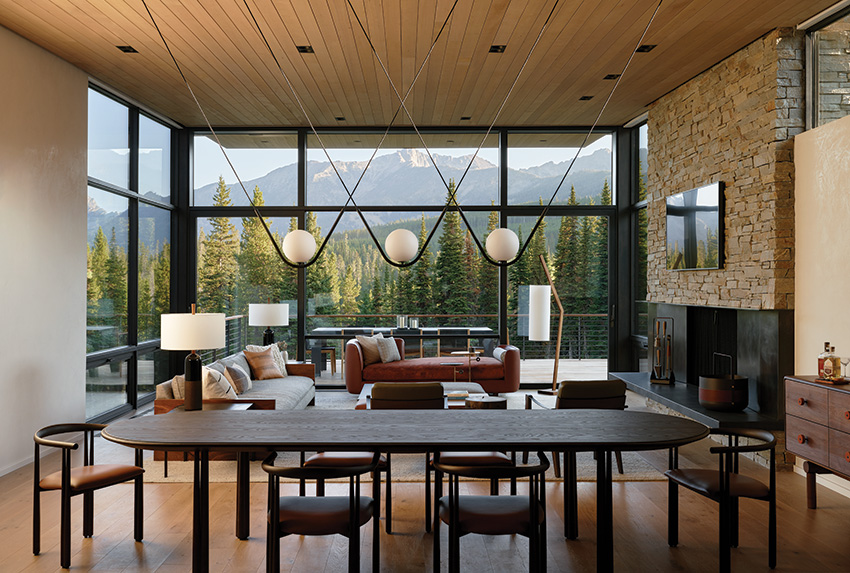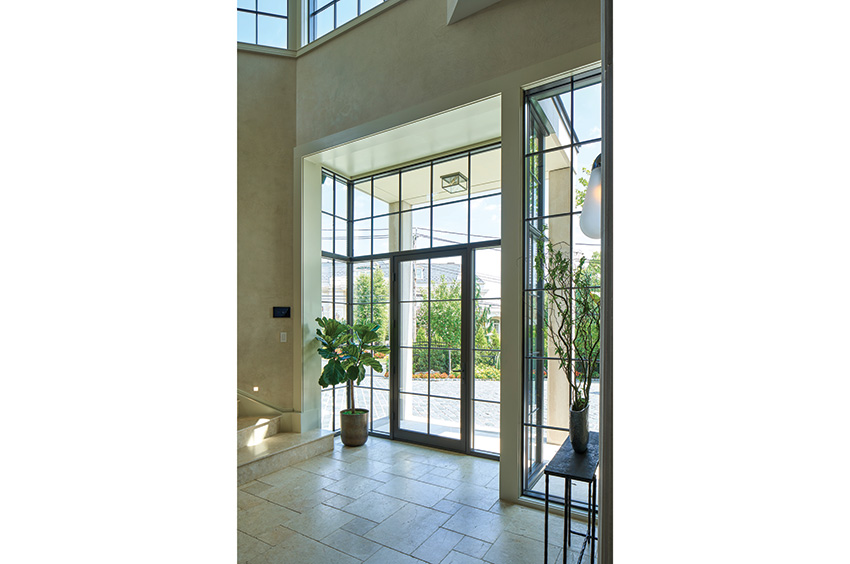Beyond Windows – Designing with Large- Format Glazing
Learning Objectives:
- Identify and recognize the characteristics of different types of glazed openings in buildings and some of the safety and welfare standards that are applicable.
- Investigate the potential to achieve design goals while still meeting high-performance needs by using large-format glazing.
- Assess the options of large-scale glazing to contribute to the welfare of building occupants through light control, daylight, views, and energy performance.
- Specify the appropriate and safe types of large-scale glazed openings for different residential buildings.
Credits:
This course is approved as a Structured Course
This course can be self-reported to the AANB, as per their CE Guidelines
Approved for structured learning
Approved for Core Learning
This course can be self-reported to the NLAA
Course may qualify for Learning Hours with NWTAA
Course eligible for OAA Learning Hours
This course is approved as a core course
This course can be self-reported for Learning Units to the Architectural Institute of British Columbia
Glass and glazing are integral to all residential designs with punched or mulled windows being the most commonly used product (i.e., awnings, casements, double-hung). In this course we look beyond these well-known choices and focus on a full range of available large-format glazing systems. Such systems include fixed glazing (i.e., picture windows), fully glazed doors (swinging, sliding, multi-slide, lift slide), large bi-fold doors, and residential curtain wall systems. All of these can be used to create contemporary or traditional residential buildings that are dramatic, inviting, flexible, and very livable. At the same time, it is possible to specify any of these systems to meet a variety of performance needs based on the details of the framing, sealing, and glazing selected. These include thermal and air infiltration control to meet high-performance energy standards such as Passive House. They can also be specified to meet the demands of particular projects related to storm resistance/resilience or building material needs such as copper or bronze cladding on glazing systems. Understanding the full range of options and capabilities allows architects the opportunity to create residential designs that are delightful to live in, comfortably energy conserving, and operationally durable.

Photo: CLB Architects; Kevin Scott Photography; courtesy of Loewen Windows and Doors
Architects have many choices in selecting glazing and fenestration products to incorporate into residential designs to create inviting spaces that also perform well.
GLAZING OVERVIEW
Manufactured glazing products used in residential design are typically made from identifiable parts by any one of many different glazing product manufacturers. Of course, not all manufacturers provide the same type or style of products. Some have the capabilities to provide higher performance products than others. Certain manufacturers are also equipped to provide unique or innovative products when called for. With so many choices available, it is incumbent on the design professional to discern which products are best suited to a particular project both to meet the design intent as well as the performance requirements.
Design Options
Regardless of the manufacturer or the type of product, there are a few fundamental design aspects and options for all glazing products. Often, selecting from these aspects is influenced by the project design intent, the location, or performance requirements to meet codes or other standards. Some of the common options include the following:
- Glazing: There are fundamental choices in the type of glass used such as float/ annealed, tempered, heat strengthened, or laminated. There are also processes that affect the characteristics of the glass such as coatings, color tints, etc. The most commonly specified coating is for low emissivity (Low-E). This process helps control the flow of radiant heat through the glazing to enhance the energy performance of a building. It may change the color of the glass slightly, but not enough to be a deterrent to using it. Further, there are fabrication options such as creating double-glazed insulated glazing units (IGUs). Triple glazing is increasingly being asked for in colder climates causing certain fabricators and manufacturers to respond with product offerings to meet that demand. Determining which glass options are best suited to a project is usually an iterative process that balances the look, size, location, and performance of the glass with the other components of a glazing product.
- Frame and Sash Materials: The glass is mounted into a sash that surrounds it on all four sides. That sash is set into a frame which is the intermediary between the glazed sash and the building. There are choices in the material for these items including wood, aluminum, fiberglass, vinyl, or others, each with its own design and performance characteristics, advantages, and disadvantages. Different fenestration products may be offered in different materials by different manufacturers including different species of wood (i.e., Douglas fir, white oak, mahogany, etc.). Some woods are denser and longer lasting than others and also provide different appearances and colorations. Check with manufacturers for their standard and optional offerings.
- Prefinished Options and Colors: Different manufacturers offer different ranges of finish options for the frame and sash materials. White and dark bronze are common for vinyl and aluminum but there may be other options available too such as greys, greens, tans, and red. Wood products may be unfinished or prefinished in a full array of popular stain colors. Some finishing may include distressing of the wood for a more natural look. If a particular finish is being sought, however, don’t assume that all manufacturers have it available. It is best to check first.
- Hardware: The hardware for operable fenestration products is similarly varied by manufacturer. While the functionality of the hardware is essentially the same between one manufacturer and another, the style, color, and finish of that hardware can vary considerably. Some offer multi-point locking hardware on selected products which provides a greater degree of security. There are also European-style hardware latches and locks that may be available which are typically more robust and durable while still offering an elegant appearance.
- Enhancements: Some projects may require certain enhancements to a glazing product. For example, some can be wind-strengthened for greater wind and storm resistance where needed. Other products can be covered with more durable cladding or coatings such as non-ferrous metals like bronze or copper.
- Custom Capabilities: Some manufacturers provide their standard products and that is all. Others can readily customize the size or shape of their products as long as it remains within certain limits of their fabrication capabilities. Certain product manufacturers can offer a wide range of custom capabilities and should be consulted during the project design process to see what is readily possible.
While the variability of choices and options gives designers a lot of freedom to work with, the standardized nature of the manufacturing allows for a good degree of predictability on performance.

Photo: Narofsky Architecture; Phillip Ennis Photography; courtesy of Loewen Windows and Doors
Glazed fenestration products are available with a range of interior and exterior materials, glass types, hardware, and other features.
Performance Testing
Windows and other glazed products need to perform well in terms of their inherent structural integrity as a product, their ability to withstand weather of all sorts, and their energy-related characteristics. In order to independently determine the true performance of glazing products, there are several national testing and functionality standards that help with quality assurance. These include the following:
- Building Codes: Across all 50 of the United States, and in many countries around the world, model building codes have been adopted that are developed by the International Code Council (ICC). Referred to as the International Codes or I-Codes, they include a coordinated family of building safety codes such as the International Building Code (IBC), the International Residential Code (IRC), the International Energy Conservation Code (IECC), and 12 other specialty codes. These codes provide the minimum acceptable performance for buildings and the products used in them. In the case of residential fenestration products, The IRC and the residential portion of IECC are the most relevant in that they identify the prescriptive and performance requirements that such products need to meet when used in buildings. This includes updates that encourage or even require higher-performing triple glazing instead of just double glazing in colder climate zones.
- National Fenestration Rating Council (NFRC): Perhaps the best-known and most widely used standard for residential glazing products is done by the independent National Fenestration Rating Council (NFRC). The certified results of their testing are used to show compliance with codes including the IRC and the IECC with a label attesting to the results affixed to a tested product by the manufacturer showing its overall and specific performance characteristics. The NFRC recognizes that window performance is not limited to any single criterion. Rather, there are a number of factors that need to be looked at, tested, and assessed to determine the true overall performance of a window.
- American Architectural Manufacturer's Association (AAMA): This independent testing agency is most often used for large-format glass and fenestration products in both residential and commercial buildings. An AAMA Window Certification requires three tests: 1.) Air Leakage- Windows with a tested air infiltration rate above 0.30 cfm at 25 mph fails; below that threshold, it passes. The lower the number the less air infiltration into a building. 2.) Water Leakage- windows are subjected to 8 inches of rain per hour and increasing wind loads until water leaks through the window. The minimum standard to pass is 33 mph wind in simulated rain conditions. 3.) Structural Strength- increasing wind is blown against the glazing product until it breaks. The minimum standard that a product must withstand is 94 mph.
- Enhanced Performance Standards: Many design professionals are interested in creating buildings that exceed the minimum requirements and go beyond, excelling in the areas of energy performance or durability in particular. In that regard, there are several standards to identify the degree of performance achieved.
U-factors (the inverse of an R-value) are usually what come to mind first, which measure the rate at which a material or product transfers heat through it. When observing U-factors, it is important to differentiate U-factor variables for the insulated glass alone (e.g., ‘center-of-glass’ U) or for the window unit as a whole. NFRC utilizes the component modeling approach to calculate the whole U-factor of a window by assessing the glass, the spacer between the glass, the sash, and the frame. Of course, the size and make-up of the glass are also important - including the number of panes that make up insulated glazing units (IGUs). Ultimately, the total NFRC U-factors for windows are based on actual testing of representative manufactured units and expressed in normal fashion as a decimal value with a lower number showing less heat transfer, therefore greater energy efficiency. Ratings generally fall between 0.20 and 1.20.
The second notable factor in the energy efficiency performance of a window is the rate of air infiltration, particularly in operable windows. The International Energy Conservation Code (IECC) sets the bar at 0.20 cubic feet per minute per square foot of window as the maximum allowable air leakage rate for windows with some exceptions allowing 0.30 cfm/square foot. This is the same rate as for sliding and swing doors in commercial construction. The NFRC takes air infiltration into account when testing window units, so manufacturers pay attention to details of construction in this regard too. Proper weather sealing and tightness of fit all come into play but so does the type of window or glazed product.
Another aspect of the glass used in tested products that affects the energy performance is its solar heat gain coefficient (SHGC). This metric indicates how much solar heat passes through the glass compared to what is reflected away. The SHGC rating is expressed as a number between 0 and 1. The lower the SHGC the less solar heat is transmitted through the glass and the cooler a residence will be. In building situations where heating from passive solar gains is desired, then a high SHGC is desirable to take advantage of the free solar heat. In other situations where cooling is the primary energy driver in a building, then a lower SHGC is needed to prevent unnecessary air conditioning use.
The visible transmittance of light (VT) is the final factor which is expressed as a number between 0 and 1. The higher the VT the more visible light is transmitted through the glass. Treatments for some of the energy efficiency characteristics of glass can interfere with the ability of people to see clearly through it. Hence the VT is useful to help identify acceptable levels of clarity for views or the use of natural daylighting in buildings.
Windows and other products that meet the requirements of all three tests are declared AAMA Certified Windows with an affixed label located inside the head of the frame. AAMA Gold Label Certified Windows designates that the tested product has passed both AAMA and NFRC testing standards.

















